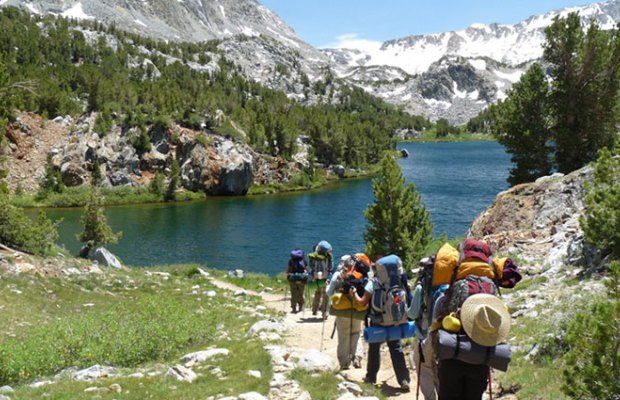Are you looking for a challenging way to put your family’s survival skills and teamwork to the test? Nothing will assess the grit and endurance of your loved ones better than leaving behind all electronic devices, cellphones, modern conveniences, electricity, the roof over your head, and your under–appreciated toilet seat. That’s right, head out on your very own backpacking expedition and venture out with only the supplies you are able to carry on your shoulders.

Our bear bag hanging high so our food was safe.
When my husband first proposed a family backpacking trip, I thought he had finally flipped his lid. He wanted to take our family, myself and our young children included, on a backpacking adventure for two nights and three days. Not only did he want us to trek through miles of secluded forest with all our food, shelter, and clothing needed for survival firmly attached to our own bodies, but he wanted us to go to the most secluded spot he could find within driving distance at a time of year when it would have the least number of other campers to give us aid or hear our desperate screams for help if the need arose. We would be descending from 3400 feet down to 1200 feet to the river below, hiking a grueling ten miles and ascending 2200 feet on our return. This would prove to be a challenging physical and mental feat for our children and me, but we accepted his dare.
As a family, we had car camped before at a lovely campground with showers and other amenities. In my mind, that was hard-core survival of the fittest. And that was as far as I imagined our family going with being one with nature. However, I was coerced by my husband and our children had been enticed by him with the promise of extreme adventure.
Starting Off

Jetboil made boiling water simple and quick.
Before setting off we had some purchases to make. Mainly, the backpacks and the tents. My husband did a lot of research and found that L.L. Bean backpacks were highly rated for the money. Upon purchasing you should pay close attention to proper fitting of the pack; it will alleviate back pain or possible shoulder injury. The tent you need doesn’t require bells and whistles, but rather your focus should be on weight and ease of set-up. Some backpackers like to sleep in a hammock with a tarp stretched overhead. We chose tents because with children, you don’t want them spread all over the woods hanging in hammocks chattering loudly to one another late into the night. Other purchases are listed below to help guide any fellow explorers.
He had researched everything from how to hang a bear bag to how to splint a broken bone. Once we had all our supplies, we had to pack the bags and weigh them, keeping in mind that a person can only reasonably carry 25% of your total body weight. I tried to claim I only weighed 75 pounds, but my husband wasn’t buying it. Each of us carried our own sleeping bags, padding and clothing. Carrying your own clothing definitely quells the temptation, as a woman, to pack more than I needed. The only toiletry I afforded myself was deodorant and a toothbrush. The weight of our tents and padding obviously had to be distributed to the adult packs. We tried making the kids carry their own, but they kept falling backwards so we relented and took the bulk of the weight.
Some important things we learned from backpacking:
- If you think you have enough toilet paper and there are girls in your group, think again. Pack more. It doesn’t weigh much, but it is much more enjoyable than a leaf.
- Take a water filter with water bottles that can screw onto them. We had two MSR MiniWorks water filters which fit our Nalgene water bottles and bladders perfectly. It was also fortunate that we had two because one stopped working on the second day. 2 is 1 and 1 is none.
- Don’t pack a 5lb bag of Costco trail mix. It sounds like an appropriate food choice, but it is too heavy for one person to carry. Break this out into individual bags and let each person carry their own serving. This was the last thing we ate.
- If you have a bad back, suck it up and purchase ample inflatable padding. My husband had purchased the simple military style foam padding roles and they weren’t enough to block out the rocks and roots on the trail. An inflatable mattress costs more, but it is lightweight and will keep you from aches and pains that could impede your progress and make you a miserable companion.
- Pack a GPS and a map encased in a Ziploc baggie. Even if you are an expert ninja tracker, it is an excellent time to teach others in your group how to navigate. We let our children take turns getting us to the next camping spot (with our guidance) and this allowed them to learn how to read a map and recognize their surroundings.
- Your camp stove can make life easy or very difficult. We used a Jetboil for quick cups of coffee and effortless boiling of water (usually under 2 minutes) for our freeze-dried food. As an added bonus, this handy dandy invention will allow you to boil water if your filters go out, too. We took one canister of fuel and a spare, but didn’t even use 1/2 of one canister.
- Lastly, but not least, first-aid is crucial. Pack a light and basic kit. We ordered this ultra-light kit from Amazon. You will need to play through every possible scenario in your mind and be prepared to make do with the supplies you are able to carry. We also packed a couple of extra trauma bandages and cut out some band-aids.

Chicken Parmesan. Yum!
Into the Woods
The trek into the place where we wanted to camp took a lot of effort and teamwork. It was a steep incline and the small rocks under our feet proved treacherous; especially with the extra weight on our backs. We strongly advise anyone taking children on backpacking exploits to go over all the details and safety guidelines weeks before the trip. I have always found that if you prepare them for the worst it will pay off with fewer accidents and aggravations. We additionally drove home the well-known fact that whiney kids will attract vicious wild animals because any high-pitched exasperating sounds can be incorrectly mistaken for injured prey. We recommend that you build multiple breaks into your destination time because smaller children need to stop more often to rest. Our site was near a beautiful river with rocks that the kids could climb on. Our tents were easy to assemble and set up and it was glorious to finally peel the packs off and devour a hot meal.

This was our home for 3 days.
That night, we listened to nothing but the sound of the forest and the roaring river as we drifted off to sleep. And let me be clear, you will not sleep as well as in your own bed on a Tempur-pedic mattress, but you will be comforted by the fact that you don’t have to sleep with the pack on. After awaking early in the morning and having coffee by the campfire (is there anything better?) we set off for the next site. Along the way, we prattled about everything under the sun, sang some ridiculous songs, admired nature, and discussed the effort it took to survive without the luxuries of home. There were moments where we crossed over dangerous narrow paths, stepped dangerously close to venomous snakes, and we had to help another up after they took a nasty spill. Our kids also learned invaluable lessons about survival, such as, how to make use of what nature provides, work together, and follow directions.
If you ask any of our children what one of their favorite family vacations was, they will always fondly recall our first backpacking trip and we can be somewhat assured that if push came to shove, our family could thrive when thrown into any unknown circumstance where we depended on one another for survival.




